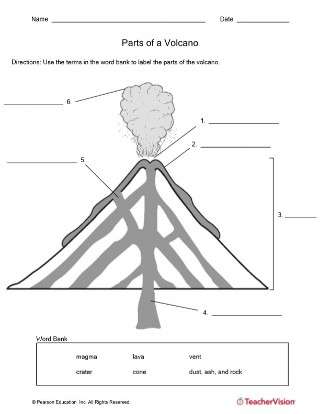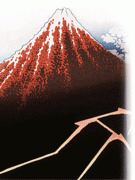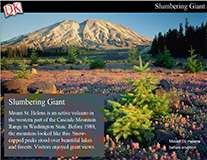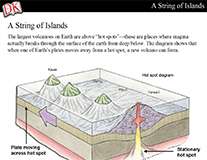Volcano Parts Labeled: Free Printable Worksheet
This printable can be used as a post-unit assessment for earth science or volcanoes and earthquakes, or can be assigned as a take-home or independent completion activity. An answer key is provided with the volcano parts labeled.
What are the Parts of a Volcano Mentioned in this Worksheet?
- Magma: This is the molten rock material present beneath the Earth's crust. When it rises to the surface, it can lead to the formation of a volcano.
- Lava: This is the molten rock that erupts from a volcano. Once it reaches the Earth's surface, magma becomes lava.
- Vent: This is the outlet or opening through which magma, gases, and other volcanic materials are expelled during an eruption.
- Crater: This is the hollow area or pit at the top of a volcano. It is formed by the collapse of material during volcanic activity. It is through the crater that lava, ash, and gases are expelled during an eruption.
- Cone: This is the visible, outer part of the volcano that is often shaped like a funnel. It is built up from the hardened lava, ash, and other materials that are ejected during eruptions.
- Dust, Ash, and Rock: These are the solid particles that are ejected during a volcanic eruption. Dust is the finest material, while ash consists of slightly larger, often sharp fragments. Rocks, or volcanic bombs, are the largest materials expelled and can range in size from small pebbles to large boulders. All these materials contribute to the buildup of the volcanic cone and can be spread over large areas during an eruption.
Further Information & Extention Activities: Volcano Parts Labeled
Glossary of Volcano Terms
The following vocabulary words relating to volcanos will enhance your teaching of the volcano parts labeled worksheet. Make sure your students understand the following terms when learning about volcanos.
- Summit: The summit is the highest point or apex of a volcano. This is typically where the crater is located.
- Conduit: The conduit is the underground passage through which magma travels from a magma chamber to the Earth's surface.
- Flank: The flanks are the sides of a volcano. They can be steep or gently sloping, depending on the type of volcano and its eruption history.
- Parasitic Cone: A parasitic cone is a smaller volcano that forms on the flank of a larger volcano. These can occur when magma finds a weak spot in the side of the volcano and breaks through to the surface.
- Magma Chamber: A magma chamber is a large pool of molten rock beneath the Earth's surface. Magma in these chambers can cause an eruption if it rises to the surface.
- Pyroclastic Flow: A pyroclastic flow is a fast-moving current of hot gas and volcanic matter that moves away from a volcano during an eruption.
- Tephra: Tephra is a general term for any material ejected from a volcano during an eruption. This can include dust, ash, and larger rocks.
- Pumice: Pumice is a type of volcanic rock that is light and porous. It forms during explosive eruptions when gas-filled lava is thrown into the air and cools quickly.
- Sill: A sill is a sheet-like intrusion of magma that has squeezed between layers of existing rock beneath the surface of the Earth.
- Dike: A dike is a vertical or nearly vertical sheet of magma that cuts across the layers of rock beneath the Earth's surface.
Types of Volcanoes
Once your students understand how volcanoes are formed and can label the different parts of one, teach them about the different types of volcanoes.
Shield Volcanoes
Shield volcanoes are large, broad volcanoes where lava pours out and builds up slowly over time, forming a shield-like shape. This type of volcano typically has a low profile and is named for its resemblance to a warrior's shield. The eruptions from these volcanoes tend to be fairly gentle with lava flows that move slowly down the sides of the volcano.
Composite Volcanoes
Also known as stratovolcanoes, composite volcanoes are characterized by a conical shape and are built up by many layers (strata) of hardened lava, tephra, pumice, and volcanic ash. These volcanoes are typically quite large and have steep sides. Their eruptions can be quite explosive.
Cinder Cone Volcanoes
Cinder cone volcanoes are the simplest type of volcano. They are built from particles and blobs of congealed lava ejected from a single vent. As the gas-charged lava is blown violently into the air, it breaks into small fragments that solidify and fall as cinders around the vent to form a circular or oval cone.
Lava Domes
Lava domes are created when small amounts of thick, viscous lava are pushed out from a vent and pile up around it. These domes can explode violently and unpredictably, releasing large amounts of hot gas and rock.
Further Volcano Lesson Plans, Worksheets, & Activities
Activity: Build a Volcano (Grades 3-6)
In this lesson plan, students will build their own volcanos using common kitchen supplies. This fun science activity is perfect for National Chemistry Week (October), or any time of the year.
Worksheet: Volcano Word Search
Quiz your students on important volcano vocabulary terms with this fun volcano word search!
PowerPoint Slideshow: Hot Rocks Mini-Lesson
Use these PowerPoint slides to review the concept of "hot spots" and to discuss the different kinds of lava that flow from active volcanoes.
Science Reading Warm-Up: Volcanoes
Students will learn about volcanoes as they improve their reading comprehension skills with the science reading passage and questions in this printable warm-up.
Find more Volcano-themed resources on TeacherVision!
















